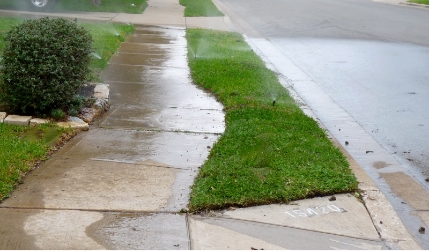
Turner Turf Farms Corp.
Copyright 2024 Turner Turf Farms Corp.
To Order Call (or Text) 435-229-8576
-229-8576
Watering
1. Water running down the gutter is water you pay for that isn’t watering your lawn. A well designed and maintained sprinkler system will save you water.
2. Once a week walk through your sprinkler system while its running to make sure its watering your lawn and not the sidewalk or driveway.
3. AFTER THE FIRST TWO WEEKS, its time to transition to normal watering schedule.
- Water deeply and less often
- Let your lawn dry down between waterings, this forces the roots to go deeper in the soil.
- Ideally one month after installing turf you should be able to water every 2 days during the hot summer months. The second year every 3 days.
4. Automatic timers have a cycle/soak feature that can convert a single 15 minutes of watering into three 5 minute waterings over several hours, which can save water if you have water runoff.
5. An Automatic sprinkler IS NOT set it and forget it. Another feature of sprinkler controllers is the Water Budget, which makes it simple to apply more or less water as the weather changes. Adjusting the Water Budget from 100% to 70% will apply 30% less water. Adjusting it from 100% to 110% will apply 10% more water across all stations.
6. Newer internet connected sprinkler controllers use precipitation data from several sources to automatically adjust sprinklers as the weather changes.
7. During our monsoon season, when its hot and humid in the morning and we get thunderstorms in the afternoon, make sure you let your lawn dry down between rains or waterings.

Fertilizing
1. Every bag of fertilizer has three numbers on it. The first number is the percentage (by weight) of Nitrogen, the second number is Phosphorous, and the third number is Potassium. Nitrogen promotes leaf growth, Phosphorous promotes root growth, and Potassium promotes disease resistance. We recommend fertilizers that have numbers in the 10 to 20 range, as even across the three numbers as you can find. Examples include 15-15-15, 16-16-8, 9-9-9, etc.
2. Lawns require 1 lb of nitrogen per 1,000 sqft on each application, late winter, late spring (before it gets hot), and fall. For a 1500 sqft lawn each application from a 50 lb bag of 15-15-15 fertilizer would be approximately 11 lbs of fertilizer. (15% x 50) x 1.5
3. Fertilizers can also contain Iron (makes your lawn greener) and micro nutrients which plants use in small quantities. Iron will stain concrete driveways and sidewalks. After applying a fertilizer containing Iron make sure to blow any granules off concrete before watering.
4 DURING HOT SUMMER MONTHS DO NOT APPLY FERTILIZER CONTAINING NITROGEN, if you apply anything during these months only apply Ironite to keep it green.